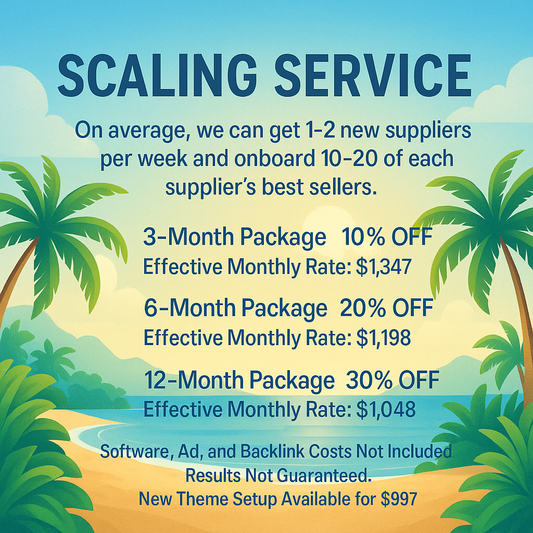
Analyzing Profit Margins in High Ticket Dropshipping: Supplier Impact and Financial Insights
 In the vast landscape of eCommerce, high ticket dropshipping has emerged as a game-changing business model, offering entrepreneurs the opportunity to earn substantial profits without holding inventory. While the concept of dropshipping isn't new, the focus on high ticket items has added a new layer of complexity to the equation. In this article, we'll delve into the world of high ticket dropshipping, its suppliers, and how analyzing profit margins can provide valuable financial insights.
In the vast landscape of eCommerce, high ticket dropshipping has emerged as a game-changing business model, offering entrepreneurs the opportunity to earn substantial profits without holding inventory. While the concept of dropshipping isn't new, the focus on high ticket items has added a new layer of complexity to the equation. In this article, we'll delve into the world of high ticket dropshipping, its suppliers, and how analyzing profit margins can provide valuable financial insights.
Understanding High Ticket Dropshipping: A Quick Overview
High ticket dropshipping is an eCommerce strategy that involves selling premium-priced products without having to maintain physical inventory. Instead, the retailer partners with suppliers who handle the storage, packaging, and shipping of products directly to the customers. Unlike traditional dropshipping, high ticket dropshipping centers around selling products with a higher price tag, often in the range of hundreds or even thousands of dollars. This approach allows for substantial profit margins, but it also comes with unique challenges.
The Role of High Ticket Dropshipping Suppliers: Impact on Profit Margins
Selecting the right suppliers is a pivotal decision in the high ticket dropshipping journey. Suppliers not only influence the quality and delivery of products but also directly impact profit margins. Here's how:
1. Product Quality and Reputation: High ticket items demand exceptional quality and reliability. Suppliers with a solid reputation ensure that the products meet customer expectations, reducing the risk of returns and negative reviews.
2. Pricing and Markup: Supplier pricing directly affects the retailer's pricing strategy. With higher-priced items, even a small discount from the supplier can lead to significant savings for the retailer, boosting profit margins.
3. Shipping and Handling Costs: Since high ticket items often come with added shipping costs, understanding how suppliers calculate these costs is crucial. Negotiating favorable shipping terms can further enhance profitability.
4. Customization and Branding: Some high ticket dropshipping suppliers offer customization options or white-label products, enabling retailers to establish their brand identity. This can lead to higher perceived value and potentially higher profit margins.
Analyzing Profit Margins: Key Financial Insights
Profit margins in high ticket dropshipping are influenced by various factors, each requiring careful analysis. Here are some financial insights to consider:
1. Gross Profit Margin: Calculated as (Total Revenue - Cost of Goods Sold) / Total Revenue, this metric highlights how efficiently a business produces goods at a profit. High ticket items typically have a more substantial margin, but associated costs like marketing and customer service should be accounted for.
2. Operating Expenses: Beyond the cost of goods, high ticket dropshipping entails additional expenses such as advertising, website maintenance, and customer support. Ensuring that these costs are manageable is essential for maintaining healthy profit margins.
3. Customer Acquisition Cost (CAC): High ticket items might require a more targeted marketing approach, potentially impacting CAC. Understanding how much it costs to acquire a customer is crucial for determining the sustainability of profit margins.
4. Return on Investment (ROI): ROI helps evaluate the effectiveness of marketing campaigns and other investments. Monitoring ROI aids in optimizing strategies to achieve better profit margins.
Strategies for Maximizing Profit Margins
1. Niche Selection: Choosing a profitable niche that aligns with high ticket items can set the stage for strong profit margins.
2. Supplier Negotiation: Skillful negotiation with suppliers can lead to better pricing, shipping terms, and customization options, ultimately boosting margins.
3. Upselling and Cross-Selling: Offering complementary products or premium versions of items can increase the average order value, enhancing profit margins.
4. Streamlined Operations: Efficient order processing, inventory management, and customer service can reduce overhead costs and improve margins.
Conclusion
High ticket dropshipping presents a lucrative opportunity for eCommerce entrepreneurs willing to navigate its complexities. By understanding the impact of suppliers on profit margins and analyzing key financial metrics, businesses can make informed decisions that drive success. As the eCommerce landscape continues to evolve, harnessing the power of high ticket dropshipping suppliers and maintaining a keen focus on profit margins will undoubtedly be a winning strategy for years to come.
So, whether you're a seasoned eCommerce entrepreneur or someone considering diving into the world of high ticket dropshipping, remember, the right suppliers and a thorough grasp of profit margins can make all the difference in your journey to eCommerce success.


















